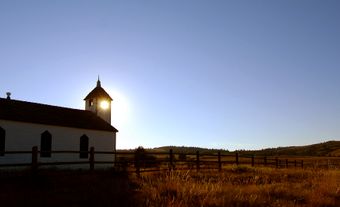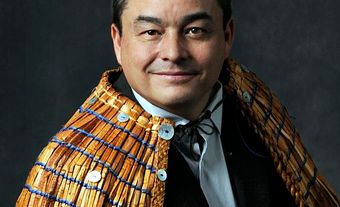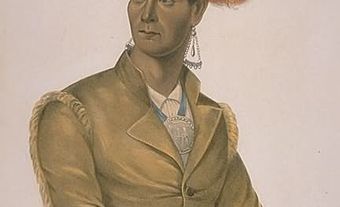
Early Life and Education
Phil Fontaine was born into in an Ojibwe family of ten brothers and two sisters. After the death of his father when Fontaine was six years old, his mother worked several jobs to support her family; she was also involved in politics, becoming the first Indigenous woman in Canada to be elected to a band council in 1952. Fontaine was inspired by his mother’s example to become involved in politics, and was motivated by his experiences in the residential school system.
Like many Indigenous children at the time, Fontaine spent ten months of every year at a residential school. For seven years he was a student at the Fort Alexander Indian Residential School, which was run by the Oblates of Mary Immaculate at Sagkeeng. This was followed by three years at the Assiniboia Residential School, a high school in Winnipeg. He completed his secondary education at Powerview Collegiate in 1961.
Residential School Experience
In 1990, Phil Fontaine became one of the first people to speak publicly about the physical, psychological, and sexual abuse he received while a student at the residential schools. He gave a number of media interviews, outlining the abuse and calling for a public inquiry. This led other former students to open up about their experiences, including his cousin Theodore Fontaine, who attended the same schools and later published the memoir Broken Circle: The Dark Legacy of Indian Residential Schools (2010). In 2012, Phil Fontaine and his brother Bert adopted Winnipeg Archbishop James Weisgerber as a member of their family in a traditional Ojibwe ceremony, as a gesture of reconciliation with the Roman Catholic Church.
Early Political Career (1973–91)
While a youth activist with the Canadian Indian Youth Council and the Company of Young Canadians, Phil Fontaine began to see self-determination and the fulfilment of land and treaty rights as the solution to poverty. He implemented these ideas when he became chief of the Sagkeeng First Nation in 1973, establishing the first education system in Canada to be controlled by Indigenous peoples, the first Indigenous-controlled alcohol treatment centre, and a locally managed Child and Family Services agency.
After a period in Yukon as Regional Director General with the Canadian government, Fontaine returned to Manitoba, completing his Bachelor of Arts in political science at the University of Manitoba in 1981. In the early 1980s he was elected as Manitoba Regional Chief for the Assembly of First Nations. He played an important role in the defeat of the Meech Lake Accord, which would have given Quebec—but not First Nations— special status as a “distinct society” within the constitution.
Grand Chief of Manitoba (1991–97)
Phil Fontaine was elected Grand Chief of the Assembly of Manitoba Chiefs in 1991. As Grand Chief he negotiated the Framework Agreement Initiative, which outlined a ten-year process that would eventually return all legislative, executive, and judicial powers to the First Nations of Manitoba. (In January 2007, the Assembly of Manitoba Chiefs voted to dissolve the agreement, alleging a lack of interest and support on the part of the federal government.)
First Term as National Chief (1997–2000)
In 1997, Phil Fontaine was elected National Chief of the Assembly of First Nations, with a focus on economic development, finding a settlement for the abuses of the residential school system, and building a more harmonious relationship between First Nations and the federal government. In 1998, Fontaine and the AFN negotiated a Statement of Reconciliation, in which the federal government apologized for past actions and policies and committed $350 million for a healing fund to help former students of the residential schools who had suffered physical and sexual abuse.
However, some criticized the pragmatic relationship between Fontaine and the federal government, and he was defeated in the 2000 elections by Matthew Coon Come, who adopted a more confrontational approach. In 2001, Fontaine became Chief Commissioner of the Indian Claims Commission (ICC), an independent body established to look into claims rejected by the federal government. During his tenure, the ICC played an important role in resolving the long-standing land claim of the Kahkewistahaw First Nation in Saskatchewan, which received $94.6 million in compensation for the surrender of 13,000 acres in 1907.
Second and Third Terms as National Chief (2003–09)
Phil Fontaine resigned from the ICC in 2003 in order to run again for election as National Chief of the AFN; he won the 2003 and 2006 elections, becoming the first person to serve as national chief for three terms. Under his leadership the AFN played an important role in negotiating the Kelowna Accord (2005), which would have committed over $5 billion to improve the quality of life of Aboriginal people in Canada. After the accord was cancelled by the Conservative government, Fontaine and the AFN, in November 2006, launched the campaign Make Poverty History: First Nations Plan for Creating Opportunity.
Fontaine was also instrumental in negotiating the Indian Residential Schools Settlement Agreement, which came into effect in 2007, and the formal apology made by Prime Minister Stephen Harper to residential school survivors the following year. Also in 2007, Fontaine worked with Harper and Jim Prentice, then Indian Affairs Minister, to establish an improved claims commission aimed at resolving outstanding land and treaty claims.
As national chief, Fontaine also signed the Declaration of Kinship and Cooperation among the Indigenous Peoples and First Nations of North America (1999) with the National Congress of American Indians. He was the first Indigenous leader to address the Organization of American States. Fontaine also lobbied for the UN Declaration on the Rights of Indigenous People (adopted in 2007).
Career and Activism Since 2009
Phil Fontaine has continued to advocate for Indigenous people since his third term as national chief ended in 2009. That year he established Ishkonigan Consulting and Mediation, which provides mediation and consultation services to Indigenous communities, businesses and all levels of government. In September 2009 Fontaine became Special Advisor to the Royal Bank of Canada, counselling the company on relations with Indigenous communities, governments and businesses. In March 2010, he joined the legal practice Norton Rose OR (formerly Ogilvy Renault) as a senior advisor, working with Canadian and international clients on Indigenous relations, energy, mining and environmental issues. Fontaine remains an influential voice on the political scene, meeting with federal politicians (e.g., Bob Rae in 2013) to discuss relations between Indigenous people and the federal government.
Recognition2Action Campaign
As Canada prepared to celebrate the 150th anniversary of Confederation in 2017, Phil Fontaine launched the Recognition2Action campaign with his long-time partner, University of Calgary law professor Kathleen Mahoney. The campaign aims to educate people about the role of Indigenous people in the founding of Canada. A key goal of the campaign is to have Parliament pass legislation that formally and legally recognizes the status of Indigenous peoples as Founding Nations of Canada.
According to Mahoney, such legislation would create a framework for future decisions regarding political representation, economic participation and language, among other issues. This reflects recommendations made by the Truth and Reconciliation Commission in 2015, particularly the demand that the Government of Canada “reconcile Aboriginal and Crown constitutional and legal orders to ensure that Aboriginal peoples are full partners in Confederation, including the recognition and integration of Indigenous laws and legal traditions in negotiation and implementation processes involving Treaties, land claims, and other constructive agreements” (Truth and Reconciliation of Canada Commission: Calls to Action, No. 45). Indeed, Fontaine has referred to official recognition as the “ultimate form of Reconciliation.”
According to Fontaine, “the correct and powerful narrative of Canada’s origins will become part of the shared story of every Canadian for generations to come. It will open up possibilities for genuine and lasting Reconciliation. Finally, it would be a moment for the ages, that all Canadians, including our peoples, could finally celebrate, in the true sense of the word, the founding of Canada. Our country.”
Criticism
Despite his achievements, Fontaine has been criticized for being too close to the federal government and big business. In February 2013, documents were released that showed Fontaine had worked with the RCMP and provincial police in the summer of 2007 to coordinate responses to the National Aboriginal Day of Action protests. Some critics charged that by so doing, Fontaine and the Assembly of First Nations were in fact working against their own people.
Fontaine has also been criticized for his links to corporations, including RBC and TransCanada Corp. A pragmatist, he believes that Indigenous involvement in resource development will help alleviate the poverty facing many First Nations. Others, however, have disagreed with his approach, labelling him a sell-out to corporate Canada.
Awards and Honours
- National Aboriginal Achievement Award (1996)
- Honorary LLD, Royal Military College (1999)
- Honorary LLD, Brock University (2004)
- Member of the Order of Manitoba (2004)
- Honorary LLD, University of Windsor (2005)
- Honorary LLD, Lakehead University (2005)
- Honorary LLD, University of Winnipeg (2008)
- Honorary LLD, University of Calgary (2009)
- Honorary LLD, University of New Brunswick (2010)
- Honorary LLD, Brandon University (2010)
- Honorary LLD, Western University (2010)
- Honorary LLD, University of Guelph (2010)
- Honorary LLD, Queen’s University (2010)
- Human Rights Education Award, Equitas (2010)
- Honorary LLD, Ryerson University (2011)
- Distinguished Canadian Leadership Award, University of Ottawa (2011)
- Officer of the Order of Canada (2012)
- Honorary LLD, Carleton University (2013)
- Honorary LLD, University of Toronto (2017)

 Share on Facebook
Share on Facebook Share on X
Share on X Share by Email
Share by Email Share on Google Classroom
Share on Google Classroom




